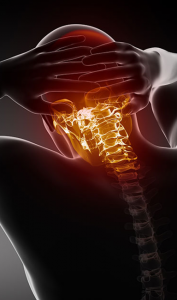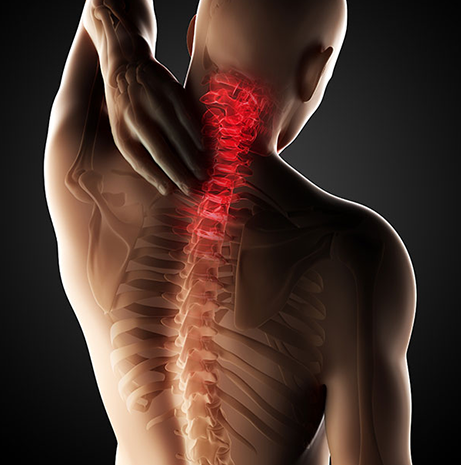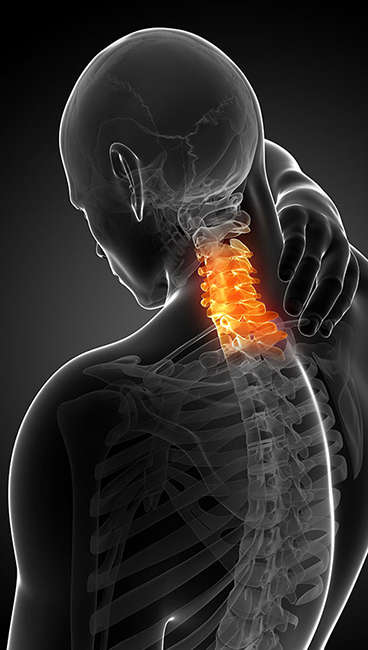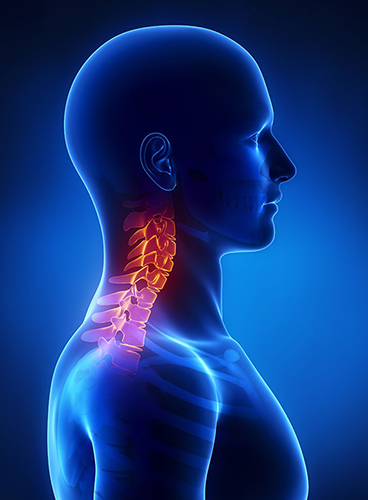If you’re reading this article, you (or someone you love) are either suffering from neck pain or investigating ways to treat or get relief from a sore neck. Alternatively, the movement of your head and neck may be limited. This article is written to help you understand the structure of your neck (neck joints, discs, ligaments, nerves, blood vessels and muscles) and how tension or imbalance in the structure could cause different types of neck pain.
A sore neck is damage to the underlying structures, but the intensity and area of your pain may vary whether you’re moving or not. Changes in your pain is a key clue to pinpoint the culprit. Changes in frequency, color, spread, duration and reaction to load or rest is vital to help you judge the urgency of getting treatment for your neck pain. See how we handle different types of neck pian and injury.
Treatment requires us to distinguish between four types of neck pain; accident/injury with trauma, acute/sudden neck pain with no trauma, slow progressing neck pain and chronic neck pain. This article includes examples to assist you in correctly relaying (to a health care professional) the type of neck pain you are facing.
This article is concluded with a description of what you can expect from a physiotherapy session (at Cilliers & Swart Physiotherapist) and a brief summary of our physiotherapists’ experience in treating patients with neck pain.
Structures in the neck
Your neck joins your head to your body. The neck enables you to move your head and eyes to see and avoid obstacles in your way, or to turn to investigate a noise you are hearing. Explaining the cause of your neck pain, requires us to look at the different structures, which forms your neck, and how they impact each other. These structures include; neck joints, discs, ligaments, nerves, blood vessels and muscles. You can get neck pain from damaging or injuring any one of these structures. Now, let us explore each one individually.

Do you experience pain in your neck when moving your head? Looking down at your phone? Checking your blind spots whilst driving? Or looking up at a signpost?
Each person’s case is unique and we want to address your specific needs. If you would like us to investigate or provide some insight, we invite you to contact us by clicking the link below.
Neck joints (also known as cervical vertebrae)
Cervical pain could be caused by damage done to any one of the seven cervical vertebrae. These seven vertebrae are counted from the bottom of your skull (C1 & C2) to the middle of your torso (where the thoracic vertebrae starts). Compared to the other vertebrae, the structure of C1 and C2 are unique,. C1 and C2 joins to form a pivot joint, which allows you to rotate your head from side to side, for example; when following the ball during a tennis match. The vertebrae of C3 to C7 look similar in shape. These vertebrae assist you in looking up and down or when bend your neck to touch your shoulder with your ear. All the joints (C1 to C7) need to work in harmony and naturally form a curve, called the cervical lordosis. Injury, damage or displacement (in the curve) of any one of these joints can cause a sore neck.
Interesting fact: The C1 cervical vertebrae is named “Atlas” after the Titan warrior who is condemned to carry the heavens on his shoulders by Zeus, in Greek mythology.
Neck discs
Between each of the previously mentioned cervical vertebra is a disc (except for C1 and C2). These discs are circular in shape and have a tough (stringy) outer layer to protect a soft gel-like inner. When your neck joints are put under pressure (or twist and bend in tricky positions), these discs absorb the shock and tension. Neck discs are prone to tearing. A bulging neck disc can limit the space meant for nerves, essentially pinching the nerve. A pinched nerve is commonly known as a “slipped disc” and can be very dangerous.
Neck ligaments
The cervical vertebrae and neighboring discs are connected to each other with different ligaments to help stabilize your head and body as you move. When ligaments are too loose, they struggle to steady your movements. Stretching and compressing ligaments can cause damage and result in pain. The most common sudden neck pain injuries (regarding ligaments) include Whiplash, falling or tackling. Together, the neck joints (bony bits), discs and ligaments keep the spinal cord safe by controlling your range of movement.
Spinal cord & nerves
A round channel is seen when looking at your spine from above. This ‘hole’ runs from your brain to your lower back and provides the space needed for your nerves (grouped together to form your spinal cord). Above (C1 to C7) or below (C7) each vertebra, nerves branch out to form nerve roots. These nerve roots merge and divert to supply and relay messages of sensation from limbs (like your arms) to the brain.
These nerves can be scratched or irritated by the surrounding structures. For example, a bulging neck disc can take up space meant for nearby nerves, essentially pinching the nerve. A pinched nerve in your neck should be treated promptly to prevent lasting effects.
Neck blood vessels
Alongside the vertebrae run important blood vessels which supplies your brain with rich, oxygen filled, blood. Interrupting the blood supply is potentially devastating. Blockages in the vessels or pooling of blood (in the tissues) can put pressure on the other neck structures, which would cause pain. Blood vessels nearest to your skin’s surface are in the area just below your jawbone, where you can feel your pulse (if you press gently with your index finger).
Neck Muscles
Sudden neck pain can be the result of a muscle spasm. Neck muscles attach to the skull and vertebrae in layers. Muscles pull together or stretch in harmony to create movement. Neck muscles spasm for protection or because of sudden or prolonged tension. When neck muscles are injured through neck muscle strain (e.g. whiplash during a car accident), Cilliers & Swart Physiotherapists will be able to diagnose and treat your neck muscle injury.
We encourage you to contact us and get professional help in diagnosing and treating your neck pain – especially if you take into consideration the many underlying structures (which make up your neck) covered in this section.

Causes of neck pain
Neck pain is a symptom, first and foremost – not a disease or illness. A sore neck can be the result of a traumatic (e.g. a direct forceful blow to the neck) or a-traumatic (sleeping in an uncomfortable position) event. Causes of neck pain vary depending on the injury or damage done to the underlying structures. These structures include neck joints, discs, ligaments, nerves, blood vessels and muscles (see the previous section for more information). The cause of injury is important, for example; neck pain produced from years of bad posture, compared to neck pain from a sudden unexpected force (like whiplash). However, most patients describe their pain as having developed suddenly with no memory of injury or an associated event.
You will hear all kinds of stories concerning patients and neck pain:
- flipping their hair back while drying it
- turning their head quickly to admire a passing jogger or car
- painting their ceiling
- washing and hanging their curtains
- falling asleep on a couch in an uncomfortable position
- caught badly in a scrum
- recovering from a car accident
- coughing for long periods at a time
- twisting and bumping their head into their shoulder while standing
The intensity of the pain can vary from a sharp pain to prolonged chronic pain. No matter what your story is, we can help you get relief from your neck pain.
Connecting nerves and neck pain
Do you have pain that radiates down your back, into your shoulder or down your arm? Pinched nerves or a shifted disc could be the cause of your discomfort.
Symptoms of a neck injury
A neck injury can cause pain in other parts of your body. Pain from cervical disc injuries is carried over to the shoulder and shoulder blade area. This happens when a neck disc bulges from an injury and compresses the nerve root, for example; a pain in your arm can be related to its nerve being pinched by the neck disc (where the root of the nerve emerges from the spinal cord).
In the case of injured cervical facet joints, you will experience pain related to specific areas. Your neck pain can also be on one side only. The joints can lock and become extremely painful, to the point that turning your head is no longer an option. Alternatively, a muscle spasm may be part of your neck pain. Neck injuries are also known to cause headaches.
Types of Neck Pain
Accident or injury – with trauma
A growing stiffness in the neck after an unexpected; fast movement, fall or direct force to the head. The most common cause usually involves either a fall or an accident where the head is rapidly forced forward and out of the neck’s natural range of movement. The forced and unnatural movement triggers the muscles to contract whilst they are in an over stretched position, causing small tears to form on them. This is not even mentioning the small joints being crushed between the neck vertebrae.
This type of neck pain usually gets worse and develops into sharp stinging pain, especially when the Cervical facet joints are involved. These are small hand-like joints that connect the neck vertebrae to one another. They need to slide and glide over one another in order to move the neck in all directions.
When these surfaces are crushed together, they injure the tissue around and inside those joints. Your body attempts to heal the injured tissue by sending inflammatory sells into these joints, which in turn causes severe swelling in a confined space and results in a loss of normal neck movement.
Acute (sudden neck pain – with NO trauma)
Are you experiencing sudden neck pain just after waking up? Is it especially painful whenever you turn your head, in order to look left or right?
In most cases people experience a pinched or locked feeling at the end of their neck range. This could be attributed to a locked facet joint, meaning the joint connections between the Cervical vertebrae are injured. The joint surfaces, on the one side of your neck, are being squashed together, because you kept your neck in an unnatural position for too long (falling asleep on your stomach with your head turned to one side).
The joint capsule on the other side of the neck is trapped between the joint surfaces, meaning you will have no pain in certain positions. In other words, when you try to turn your head into a certain position, you will feel a sharp, stinging, pain shoot through your neck. Normally the one side is more painful compared to the other. Stiffness in the neck muscles increase as the day progresses, until you end up barely being able to move your head in any direction.
Physiotherapists are very effective at treating this specifically seeing as it involves; spinal joint mobilization (to release joint capsules), relieving tightened muscles and restoring normal joint movement.
Slow progressing neck pain
Prolonged postures and maintaining a certain position for long periods of time. Ever sat at the computer and lost track of time whilst browsing or working? Stop, be aware of your posture right now. Are your elbows supported? Are you looking up or down at your screen? Are your hips facing forward or are they slightly rotated (putting strain on your upper back)? To which side are you tilting your head? Left or right? All of this makes a difference… If you continue to put more strain on certain structures, you will wear out certain joints more than the opposite side and your pain will get worse.
This type of pain mostly increases and stays for longer periods (Pain from 3/10 to 7/10 and going from pain only in the afternoon to pain throughout the entire day). It may even start affecting other areas, for example; the pain could move down to your shoulder blades or upwards, to give you headaches.

Chronic neck pain
Constant or fluctuating headaches are usually a side effect of this main problem. Bearable, but irritating, burning pain or a dull ache over the skull towards the eye sockets.
The primary problem is a long standing instability in the building blocks of the neck, by either the structure(bones), cables (ligaments), or mechanics (muscle activity, balance and activation timing). The most important factor to remember is that this type of neck pain consists of more than one problem.
Physiotherapists are trained to systematically address each structure and problem individually, in order to relieve pain by correcting posture, providing stability to the neck and altering your movement patterns. If you are feeling constant neck pain, please don’t leave your neck pain for a few days and hope it gets better… You will only cause yourself more discomfort and agony.
Physio:”So, for how long have you had the pain?”
You:”…Years…”
That’s when you know it’s going to be a long process.
Structures causing sharp neck pain
Muscle
- Mild to moderate dull or aching pain with stretch
- Intermittent pain aggravated by looking down and/or to the opposite side
- Neck movements restricted by painful stretch sensation
- Pain is not well defined but generally doesn’t radiate down arm
Joint
- Mild to severe sharp pain with certain movements
- Intermittent or constant pain aggravated by looking up and/or to the same side
- Neck movements restricted by pain and locking sensation
- Pained area is very specific and well defined
Nerve
- Constant mild to severe sharp pain
- Constant pain aggravated with neck movements to same side possibly radiating down the arm
- Neck movements restricted by sharp, electrical type pain in specific movement
- Pain is not well defined but radiates down a specific nerve course
Nerve
- Constant mild to severe dull pain.
- Minor incident results in severe pain
- Constant pain aggravated with neck movements to the end of your range, possibly radiating down the arm
- Neck movements are generally restricted in all directions
- Pained area is well defined and radiates down arm with possible sensation and weakness
Diagnosis
There are a lot of structures in the neck that may be responsible for your specific symptoms. We are able to accurately evaluate your neck and find the structures responsible for the pain you are experiencing. If X rays or scans are necessary, we will refer you to the right place.

Common conditions that cause neck pain
- Postural neck pain (Forward head posture)
- Discogenic neck pain (injury to intravertebral disc)
- Whiplash injury (due to trauma)
- Acute nerve root irritation/compression (pinched nerve)
- Apophyseal/discognic wry neck (Locked neck joint)
Physiotherapist treatment
A physiotherapy treatment focuses upon identifying the structures that are producing the pain. We will guide you to avoid, or limit, certain activities or movements. During the initial phases, where the pain is most severe, we can use Electrotherapy to block the pain impulses and desensitize the nerve endings. Ultrasound and Laser can also be used to help relieve pain and accelerate healing. We use Acupuncture or Dry Needling to help heal the surrounding tissue cells and we use different types of Strapping and Taping to unload and redistribute the forces in your neck.
Massage, Soft tissue mobilization and muscle Stretches helps break down fascia restrictions and improve muscle flexibility . Myofascial release of some dominant Cervical mobilizer muscles are quite painful, but the results speak for itself.
We very rarely advocate using a neck brace, due to the secondary complications and bigger problems it could cause. We will gradually progress in neck and postural training exercises as your pain improves. The training gets monitored very closely to avoid further injuries.
Physiotherapy will aim to reduce your pain and will be experienced differently by each person. One problem may cause another to appear (similar to the domino affect), for example; a locked joint will cause a lot of protective muscle spasms, therefore, by focusing treatment upon mobilizing the joint will relieve the muscle spasms and ultimately reduce the pain.

Our professional experience on severe neck pain
Sudden and severe neck pain is the second most common symptom we see in our practice. We have compared our approach to other protocols and realized that we treat neck pain fast and effectively, if the underlying cause is determined before it becomes chronic. It’s rarely cause for serious alarm, but it still needs to be looked at. Muscle strain and inflation of the joints can give you a considerable amount of discomfort, the faster we attend to it, the faster you’ll experience relief.
The bigger problem with neck pain however lies in reoccurring or chronic neck pain, which could be due to poor posture and habitual movements. When these neck pain ‘episodes’ become more frequent and intense, you should have it checked out.
Other Causes of Neck Pain
- Joint – Neck Joint Degeneration (Cervical Spondylosis)
- Muscles – Neck muscle spasm,
- Discs – Cervical Disc injury (Slipped neck disc)
- Ligaments – Interspinous ligament sprain
- Nerve- Pinched nerve in the neck
- Bone – Cervical Facet joint sprain
- Neck pain coming form other areas
Why is your neck pain lasting longer than expected?
Experiencing these situations or applying similar advice and not getting results is a good thing. Why? Because these experiences help you understand which treatments doesn’t work for you. It means that you are closer to finding out what truly works for you!
We invite you to book an appointment with a Physiotherapist (at our Pretoria practice). During an appointment we assess your symptoms, diagnose the cause, educate you about what is happening in your body and then start treatment. See our FAQ for more in depth information about what to expect from a physiotherapy session.
Alternatively, click the link below to book a FREE phone call. The phone call is complimentary and there is no obligation to book any appointments with us after the call is over. This is an opportunity to get an expert’s advice about your situation. Our goal is to help you make an informed decision about what to do next, concerning your neck pain.
4 steps to get rid of neck pain quickly.
If you would like to know how the Physiotherapy team at Cilliers & Swart will help you, we invite you to book a FREE, no-obligation, risk-free “Call me back” phone call.
Note: This free call is a service we offer to people who are nervous or unsure. You might not know if Physiotherapy is the right treatment for you. If you are unsure, please fill out our online form. We will contact you to find out what is wrong and how we can help. There is no financial obligation or risk on your part. You have nothing to lose except your pain.

